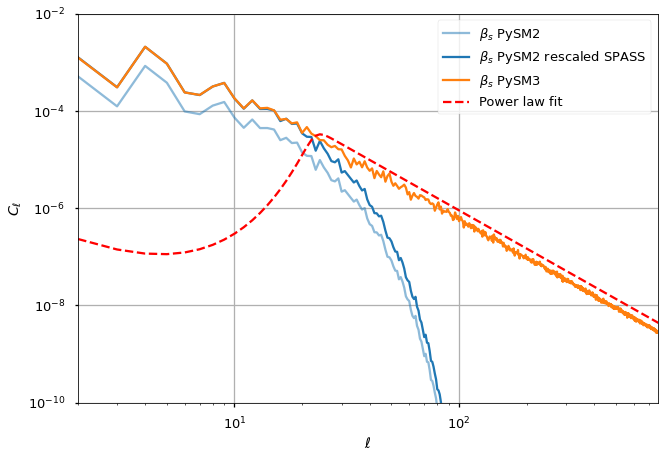Small scales on the PySM2 beta synchrotron template¶
we subtract the offset term from the \(\beta_s\) map
we use the fitted power law from the study by Nicoletta Krachmalnicoff to inject small scales on to the spectral index map
we rescale the large scale \(\beta_s\) map by a factor
~1.572which comes from the SPASS latest resultswe modulate the small scales on the \(\beta_s\) map by the same modulation map adopted for intensity
[1]:
import os
os.environ[
"OMP_NUM_THREADS"
] = "64" # for jupyter.nersc.gov otherwise the notebook only uses 2 cores
[2]:
from pathlib import Path
import healpy as hp
import matplotlib.pyplot as plt
import numpy as np
# import pymaster as nmt
from astropy.io import fits
%matplotlib inline
[3]:
plt.style.use("seaborn-talk")
[4]:
import pysm3 as pysm
import pysm3.units as u
[5]:
nside = 512
lmax = int(1.5*nside)
ell = np.arange(lmax+1)
[6]:
datadir = Path("data")
[7]:
output_dir = Path("production-data/synch")
[8]:
output_nside = 2048
# output_nside = 8192
[9]:
output_lmax = int(min( 2.5 * output_nside, 8192*2))
output_ell = np.arange(output_lmax + 1)
output_cl_norm = output_ell * (output_ell + 1) / np.pi / 2
output_cl_norm[0] = 1
The modulation used here is different from the one used for the Synchrotron templates, these are based on a heavy smoothing of the input temperature maps. The actual algorithm used is available in the documentation of PySM 3.4.0b5 https://github.com/galsci/pysm/blob/3.4.0b5/docs/preprocess-templates/synchrotron_beta.ipynb
[10]:
template_dir = "/global/project/projectdirs/cmb/www/pysm-data/pysm_2/"
beta_s_pysm = hp.read_map(template_dir + "synch_beta.fits")
print(beta_s_pysm.mean())
beta_s_pysm_nomono = hp.remove_monopole(beta_s_pysm)
print(beta_s_pysm_nomono.mean())
-2.9999962
7.461009e-08
[11]:
cl_spass_fit = 10 ** (-0.82655497) * output_ell ** (-2.60860208)
cl_spass_fit[0] = 0
/tmp/ipykernel_64107/2230800712.py:1: RuntimeWarning: divide by zero encountered in power
cl_spass_fit = 10 ** (-0.82655497) * output_ell ** (-2.60860208)
[12]:
from pysm3.utils import sigmoid
[13]:
ell_fit_low = {"TT": 10, "EE": 10, "BB": 10}
ell_fit_high = {"TT": 36, "EE": 36, "BB": 36}
sig_func = sigmoid(output_ell, x0=ell_fit_high["TT"] - 15, width=ell_fit_high["TT"] / 10)
Large scales¶
[14]:
np.random.seed(444)
cl_spass_fit *= np.sqrt(sig_func)
bs_ss_alm = hp.synalm(cl_spass_fit, lmax=output_lmax)
[15]:
## Includes rescaling from S-pass
alm_bs = hp.map2alm(beta_s_pysm_nomono * 1.5722501, lmax=lmax, use_pixel_weights=True)
bs_LS_alm = np.empty_like(alm_bs)
bs_LS_alm = hp.almxfl(alm_bs, np.sqrt(1.0 - sig_func[:lmax+1]))
[16]:
if output_nside > 4096: # only write at 8192
hp.write_cl(
output_dir / "raw" / f"synch_small_scales_beta_cl_lmax{output_lmax}.fits",
cl_spass_fit,
dtype=np.complex128,
overwrite=True,
)
hp.write_alm(
output_dir / "raw" / f"synch_largescale_beta_alm_nside{nside}_lmax{lmax:d}.fits",
bs_LS_alm,
lmax=lmax,
out_dtype=np.complex64,
overwrite=True,
)
[17]:
if output_nside < 4096:
bs_ss = hp.alm2map(bs_ss_alm, nside=output_nside)
modulate_amp = hp.alm2map(hp.read_alm(output_dir / "raw" / f"synch_amplitude_modulation_alms_lmax768.fits.gz").astype(complex), output_nside)
bs_ss *= modulate_amp
bs_ls = hp.alm2map(bs_LS_alm, nside=output_nside)
bs_out = bs_ss + bs_ls - 3.1
# output_map_alm = hp.map2alm(bs_out, lmax=output_lmax)
clout = hp.anafast(bs_out, lmax=lmax)
clin = hp.anafast(beta_s_pysm, lmax=lmax)
[18]:
if output_nside < 4096:
for ii in range(1):
plt.loglog(ell, clin, alpha=0.5, color="C%d" % ii, label=r"$ \beta_s$ PySM2")
plt.loglog(
ell, clin * 1.5722501 ** 2, alpha=1, label=r"$ \beta_s$ PySM2 rescaled SPASS"
)
plt.loglog(
ell,
clout,
label=r"$ \beta_s$ PySM3 ",
)
plt.grid(True)
plt.plot(output_ell, cl_spass_fit, "--", label="Power law fit ", color="red")
plt.legend()
plt.ylabel("$ C_\ell $")
plt.xlabel(("$\ell$"))
# plt.xlim(10, 55 )
plt.xlim(2, lmax)
plt.ylim(1e-10, 1e-2)

[ ]: